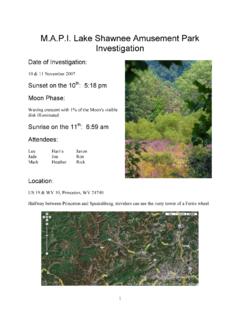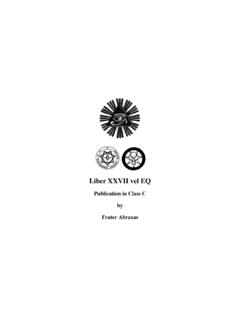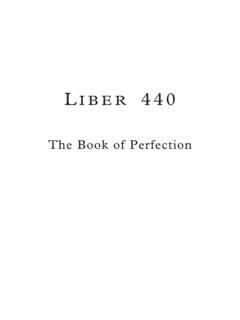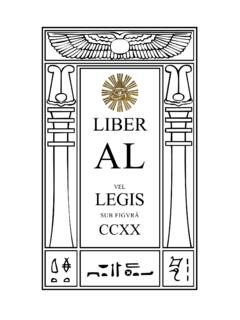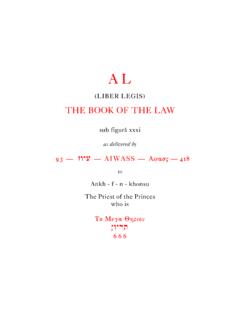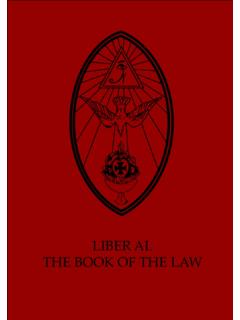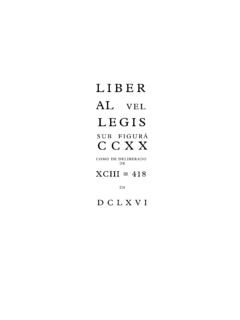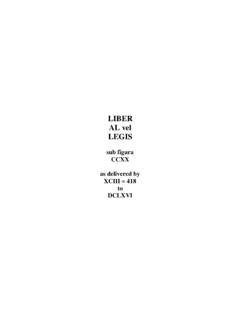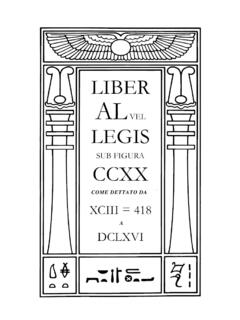Transcription of A Preliminary Guide to Liber Resh vel Helios - Meetup
1 A Preliminary Guide to Liber Resh vel Helios by Frater xvarnah-Asterion Liber Resh vel Helios (aka Liber CC or Liber 200), as written by Aleister Crowley, briefly instructs a participant to verbally and physically greet the sun four times daily (at sunrise, noon, sunset, and midnight) facing one of each cardinal directions toward the sun (East, South, West, and North respectively). Performing Liber Resh usually consists of following these instructions outlined in the document Liber Resh vel Helios , including reciting the adoration , most commonly the song contained within Chapter III, verses 37 through 38 of Liber AL vel Legis ( Liber CCXX). Devotional Practice for the Individual The daily practice of reciting Liber Resh (sometimes referred to simply as Resh ) is shared by many diverse individuals interested in Thelema, however the text was originally written for an initiatory system called A.
2 A.. which consisted of grades and teacher-student relationships (designed by Aleister Crowley and George Cecil Jones in 1906 after the Hermetic Order of the Golden Dawn ceased to exist in 1903). Because many individuals who perform Resh are not working within any of the several initiatory lineages of A..A.. the instruction within the text to give the sign of one s grade is often replaced by a variety of different signs or postures to be given at the four different times of day when reciting Resh. The text is not an instructional manual that seeks to convince the reader through rational argument how a certain effect will occur, but instead it baldly pronounces an achievement of a certain personal mindfulness and strength.
3 The concluding sentence of Liber Resh vel Helios might be read as an expressly stated goal of devoting time in your day to recite words and act in conformity with the document s instructions. From one point of view, Line 7 concludes the document s instructions with an adamant certainty that a stated effect will occur. However, the effect of one s own personal practice of Resh is not limited by this broadly stated purpose. On the contrary, perhaps one s own personal devotion in performing Resh is not fenced in , but encouraged when the document (in an inspirational tone akin to a benediction) proclaims: Thus shalt thou ever be mindful of the Great Work which thou hast undertaken -- and additionally: strengthened to pursue it unto the attainment of the Stone of the Wise, the Summum Bonum, True Wisdom and Perfect Happiness (emphasis added by myself).
4 In this manner, performance of Resh stresses the individual. The Word Resh ( resh ) is a Hebrew letter, pronounced like the English R (the word resh translates as head ). Within the Hermetic Qabalah, resh is the 30th Path upon the Tree of Life schematic (upon the diagram of the Tree that is commonly used by occultists, the 30th path connects the sephiroth of Hod with the sephiroth of Yesod, and is symbolized by the celestial body of the Sun, various solar deities, the Pelican, the Tarot Trump of The Sun). Personal Participation The brevity and instructional tone of Liber Resh vel Helios , in my opinion, does not limit the participatory nature of the text, but instead calls upon the individual to personally participate in the text.
5 Its tone is similar to an authoritative teacher (understandably so, since the document appears to be initially designed for students of A..A..). This tone might be an essential characteristic of Liber Resh as it may motivate the reader to persevere in reciting Resh as a personal systematic routine. The text does not linger to analyze its instructions, nor does it speak in an impassioned, nor an overtly dispassionate tone (however, the phrase let him repeats eight times, giving the document a certain tone of liberation). Perhaps paradoxically, the tone of the text presents both an opportunity to obey its instructions, while simultaneously, inviting free participation. Analysis and a Plurality of Perspectives Although commentaries concerning Liber Resh have been written by learned individuals, there is within the text a notable absence of analysis, which might invite the individual participant to a multitude of perspectives, and a freedom to experience Resh without limiting oneself to any one particular interpretation.
6 For example, there is no elaboration as to the purpose of giving a sign , nor is there commentary on the God-names, nor an explanation why a cardinal compass direction is attributed to that name, nor an elaboration on how to adore That which is beyond Him . Also, the text provides little elaboration on physical/imaginal/mental/vocal techniques to use when it directs one to assume the God-form of Whom thou adorest (the text s one brief direction is to do this as if thou didst unite with Him in the adoration of That which is beyond Him and a reader may find this direction has similarities to bhakti yoga exercises within Liber Astarte vel Berylli or Liber CLXXV aka Liber 175 , but its brevity also suggests to this author the opportunity for experimentation).
7 Various individuals are free to express, blog, or publicize their own methods on how to perform Resh, but other individuals commentaries do not share the same weight of authority as one s own experience. Certainly one is free to entertain any/all ideas and opinions (the ability to re-examine the relationship between you, the world, words, and the practice of Resh does not abruptly stop at the tip of your nose). Perhaps communication is an essential part of the experience of reading any text, however, I caution all readers of that any additional commentary on Liber Resh is simply another person s interpretation (in this regard, this commentary is also included, and one should feel free to disregard my perspectives in part or in whole).
8 One s own practice, and re-examination, of routinely performing Resh can be an authoritative basis to understand Resh. Thus, the comments and links listed below do not hold any more authority than you desire to attach to them. Instead these comments hopefully provoke your own explorations. The meaning and beauty of Resh might not be found in any of these typed words, but in your experiences as you make your personal individual practice of Resh your own. The below excerpt is from: (I have emphasized the portion to be spoken aloud in un-italicized bold text.) 0. These are the adorations to be performed by all aspirants to the A..A.. 1. Let him greet the Sun at dawn, facing East, giving the sign of his grade.
9 And let him say in a loud voice: Hail unto Thee who art Ra in Thy rising, even unto Thee who art Ra in Thy strength, who travellest over the Heavens in Thy bark at the Uprising of the Sun. Tahuti standeth in His splendour at the prow, and Ra-Hoor abideth at the helm. Hail unto Thee from the Abodes of Night! 2. Also at Noon, let him greet the Sun, facing South, giving the sign of his grade. And let him say in a loud voice: Hail unto Thee who art Ahathoor in Thy triumphing, even unto Thee who art Ahathoor in Thy beauty, who travellest over the Heavens in thy bark at the Mid-course of the Sun. Tahuti standeth in His splendour at the prow, and Ra-Hoor abideth at the helm. Hail unto Thee from the Abodes of Morning!
10 3. Also, at Sunset, let him greet the Sun, facing West, giving the sign of his grade. And let him say in a loud voice: Hail unto Thee who art Tum in Thy setting, even unto Thee who art Tum in Thy joy, who travellest over the Heavens in Thy bark at the Down-going of the Sun. Tahuti standeth in His splendour at the prow, and Ra-Hoor abideth at the helm. Hail unto Thee from the Abodes of Day! 4. Lastly, at Midnight, let him greet the Sun, facing North, giving the sign of his grade. And let him say in a loud voice: Hail unto thee who art Khephra in Thy hiding, even unto Thee who art Khephra in Thy silence, who travellest over the Heavens in Thy bark at the Midnight Hour of the Sun. Tahuti standeth in His splendour at the prow, and Ra-Hoor abideth at the helm.




